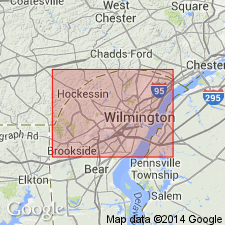
- Usage in publication:
-
- Faulkland Gneiss
- Modifications:
-
- Original reference
- Dominant lithology:
-
- Amphibolite
- AAPG geologic province:
-
- Piedmont-Blue Ridge province
Summary:
Pg. 12-13; W.S. Schenck and others, 2000, Delaware Geol. Survey, Geol. Map. Ser., no. 10, scale 1:36,000. Faulkland Gneiss of Wilmington Complex. Interlayered amphibolite, quartz amphibolite, and felsic gneiss. Rocks previously included in amphibolite A of the Wilmington Complex and in James Run Formation. Is much older than the James Run at its type locality [459 +/-5 Ma, Horton and others, 1998, GSA Abs. w/Prog., v. 30, p. 126]. Interlayered with metasedimentary rocks of the Wissahickon Formation. Intruded by Barley Mill Gneiss of Wilmington Complex to west. Along its southern boundary is in contact with Windy Hills Gneiss and along its northern boundary is constrained by outcrops and float of Montchanin Metagabbro (all of Wilmington Complex). Age of igneous crystallization is [Early Ordovician], based on isotopic dating. Zircons from a sample of felsic gneiss (locality Bc53-f) yielded a U-Pb age of 482 +/-4 Ma (J.N. Aleinikoff, USGS, personal commun., 2000).
Source: Publication.
For more information, please contact Nancy Stamm, Geologic Names Committee Secretary.
Asterisk (*) indicates published by U.S. Geological Survey authors.
"No current usage" (†) implies that a name has been abandoned or has fallen into disuse. Former usage and, if known, replacement name given in parentheses ( ).
Slash (/) indicates name conflicts with nomenclatural guidelines (CSN, 1933; ACSN, 1961, 1970; NACSN, 1983, 2005, 2021). May be explained within brackets ([ ]).

